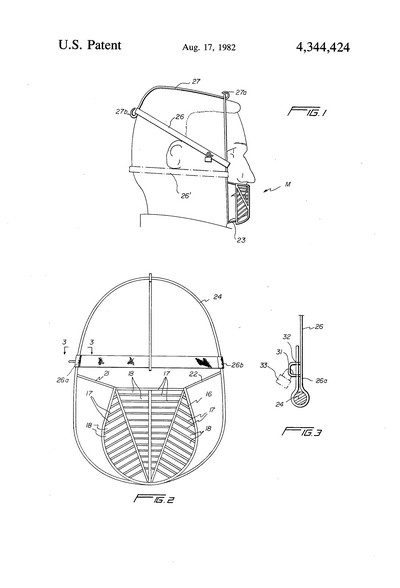October 13, 2016
Darwin’s Patent Panopticon.
Regular readers will have noticed I haven’t ranted and raved about patent trolls of late. What, all’s quiet on the troll front – they’ve stopped being trolls and started doing something useful and honest instead? You guessed it: no. Alas, every day, stories about their audaciously outrageous stunts can be found in the news if you look in the right places. It’s business as usual for the trolls; it just doesn’t make headline news.
Sometimes the news comes to you – at least, to us: just the other day we received a lawsuit from WETRO LAN for alleged infringement of a patent on filtration of data packets, or, to be more precise – a firewall. WHAT?
So, what they’re saying is, you can patent a widely-known, universally-applied device, er, which was invented more than a decade ago? Just in case you missed that: the tech had been around for ages BEFORE this patent appeared! And now they demand a fee for use of their patented tech! Hold on… WHAT?!
Yes that’s what they’re doing: since 2015 they’ve brought lawsuits to 60+ companies, many of which developed firewalls long before the patent existed. But the industry is taking the lawsuits in its stride; it even name the patent Stupid Patent of the Month.
Equally absurd is their targeting us with a claim. We’re not ‘easy pickings’ by far for an attack, since we always stand our ground and never give in to patent trolls. And we never settle out of court either – as there’s never anything to settle, as we ain’t done nuttin. The only thing we do is return fire occasionally. Well, why not? Their patents will be invalidated sooner rather than later – so we strike while the iron’s still hot there’s still an iron. And no matter what, we’ll continue the good fight – until the last bullet – their bullet.
But all this talk of fighting – no matter how necessary it is – it’s still a bit lot of a mood spoiler. So, to lighten the spirits and stay positive and optimistic, I decided to blow the dust off the archives to come up with a collection of the strangest, craziest, maddest and most paradoxical patents ever. If anything, just so you’ll know where they may bite you in the future for ‘gross violations of patent law’ :).
OK, off we go…
The Superlatively Subjective Top-5 Most [insert the appropriate] Patents Ever
No. 5: The guillotine – the best remedy for a headache.
Warm, sunny, summer weather has its downside. Of course, summer should be all about the beach, pinacoladas and swimsuits, but for that one has to be in good shape. But how can one be in good shape after a fall, winter and spring of non-stop gorging on high-calorie foods? One simply can’t! Well, one could – with a decent diet and exercise – but how unoriginal and folksy and old-fashioned is that? There had to be a hi-tech solution; after all, the 21st century was just around the corner. Therefore…
Folks, meet US patent 4344424 – the ‘anti-eating face mask’. Hannibal Lecter – move over!
PS: Makes sense to ‘invent’ and patent anti-eating handcuffs too – to chain you to the radiator with so you can’t reach the fridge. In just two weeks you’d have that beach-bod you’d been after :).







![YOU CAN NEVER GET TOO MANY AWARDS. SEE 1ST COMMENT FOR ENGLISH ⏩
"А из нашего окна страна Австрия видна!" - практически (с). Но в этих австриях я был не смотреть из окна, а по многочисленным деловым делам, первое из которых - лично получить несколько важных наград и множество сертификатов от независимой тестовой лаборатории AV-Comparatives.
Это далеко не первая наша награда. Скажу больше - на протяжении последних десяти лет по результатам независимых тестов к нам даже близко ни один конкурент не подобрался. Но почему тогда такое внимание конкретно к этой победе? Ответ простой: густопопсовый геополитизм. В наше весьма геополитически [очень мягко говоря] непростое время... Ну, если отбросить все казённые слова, то будет, как в известном анекдоте про поручика Ржевского. В той самой истории, когда ему указали повторить свою фразу без матерщины. На что тот ответил: "Ну, в таком случае я просто молчал".
Так вот, в наше "поручико-ржевско-молчаливое время" участвовать и получить первые места в европейских тестах - это за пределами научной и ненаучной фантастики. Что в целом совпадает с одной из основных парадигм моей жизни: "Мы делаем невозможное. Возможное сделают и без нас" (с). Большими трудами и непомерными усилиями - да! Это можно! Мы заделали такие продукты, такие технологии, такую компанию - что даже в непростое время нас и в Европах знают, уважают, любят и пользуются. Ура!](https://scontent-iad3-2.cdninstagram.com/v/t51.29350-15/430076034_1096357205018744_692310533755868388_n.heic?stp=dst-jpg&_nc_cat=103&ccb=1-7&_nc_sid=18de74&_nc_ohc=XLII-tX29aoAX80SM4u&_nc_ht=scontent-iad3-2.cdninstagram.com&edm=ANo9K5cEAAAA&oh=00_AfBINCtkZ3-r_aTvdSC36JELI05V6PuBnMWs672PK3GsBQ&oe=65E63D48)
























